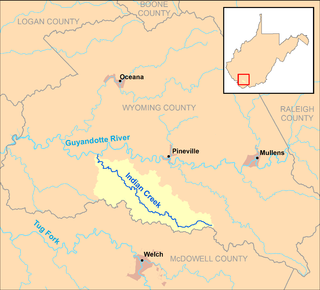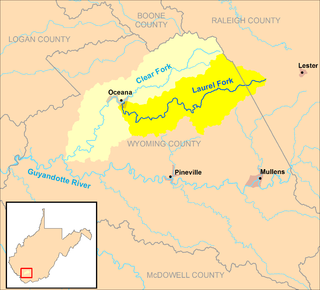
Wyoming County is a county in the U.S. state of West Virginia. As of the 2010 census, the population was 23,796. Its county seat is Pineville. The county was created in 1850 from Logan County and named for the Lenape word meaning "large plains".

Huntington is a city in Cabell and Wayne counties in the U.S. state of West Virginia. It is the county seat of Cabell County, and the largest city in the Huntington-Ashland, WV-KY-OH Metropolitan Statistical Area, sometimes referred to as the Tri-State Area. A historic and bustling city of commerce and heavy industry, Huntington has benefited from its location on the Ohio River at the mouth of the Guyandotte River. It is home to the Port of Huntington Tri-State, the second-busiest inland port in the United States.

Pineville is a town in and the county seat of Wyoming County, West Virginia, United States, situated along the Guyandotte River. The population was 668 at the 2010 census.

The National Telecommunications and Information Administration (NTIA) is an agency of the United States Department of Commerce that serves as the President's principal adviser on telecommunications policies pertaining to the United States' economic and technological advancement and to regulation of the telecommunications industry.

The Guyandotte River is a tributary of the Ohio River, approximately 166 mi (267 km) long, in southwestern West Virginia in the United States. It was named after the French term for the Wendat Native Americans. It drains an area of the unglaciated Allegheny Plateau south of the Ohio between the watersheds of the Kanawha River to the northeast and Twelvepole Creek and the Big Sandy River to the southwest. Via the Ohio River, it is part of the Mississippi River watershed.
Appalachia Service Project or ASP is a non-governmental organization which was founded in 1969. ASP addresses substandard housing using volunteer labor to perform repairs to make homes "warmer, safer, and drier." ASP operates in Central Appalachia, specifically in the states of Kentucky, North Carolina, Tennessee, Virginia, and West Virginia. The mission statement of ASP is "Appalachia Service Project is a Christian ministry, open to all people, that inspires hope and service through volunteer home repair in Central Appalachia," and ASP's vision is that "substandard housing in Central Appalachia will be eradicated and that everyone who comes into contact with this ministry will be transformed." Repairs are made using volunteer labor and at no cost to the homeowner. Between 1969 and 2015, ASP hosted 377,412 volunteers and performed repairs on 17,373 homes.

The Appalachian Regional Commission (ARC) is a United States federal–state partnership that works with the people of Appalachia to create opportunities for self-sustaining economic development and improved quality of life. Congress established ARC to bring the region into socioeconomic parity with the rest of the nation.
The Winding Gulf Coalfield is located in western Raleigh County and eastern Wyoming County, in southern West Virginia. It is named after the Winding Gulf stream, a tributary of the Guyandotte River. In the early 20th century, it was promoted as the "Billion Dollar Coalfield".
Rural Action is a non-governmental organization working in Appalachian Ohio promoting economic, social and environmental justice. The organization envisions a region of clean streams, healthy forests, thriving family farms, meaningful jobs for everyone and lively towns that remember local history and celebrate their stories.

The Slab Fork is a tributary of the Guyandotte River, 15.1 miles (24.3 km) long, in southern West Virginia in the United States. Via the Guyandotte and Ohio rivers, it is part of the watershed of the Mississippi River, draining an area of 35.36 square miles (91.6 km2) in a mainly rural area on the unglaciated portion of the Allegheny Plateau.
World Vision Appalachia is an organization of World Vision, an international Christian relief and humanitarian organization serving the world's under-resourced children and families in nearly 100 countries. World Vision Appalachia's work in Appalachia, United States began in 1983 when the organization provided a $1000 grant to help fund the construction of a basketball court in the Chestnut Ridge community of Barbour County, West Virginia. This grant and the completion of the basketball court marked the beginning of what has grown into over twenty-four years of a deepening commitment to the Appalachian region. World Vision Appalachia serves families and organizations in 37 of West Virginia's 55 counties and surrounding states.

Appalachia is a region of the Eastern United States. Home to over 25 million people, the region includes mountainous areas of 13 states: Mississippi, Alabama, Pennsylvania, New York, Georgia, South Carolina, North Carolina, Tennessee, Virginia, Kentucky, Ohio, Maryland, as well as the entirety of West Virginia.
Commonwealth Connections is a greenway and conservation initiative co-developed by the Commonwealth of Massachusetts Department of Conservation and Recreation (DCR), the National Park Service, and over fifty trail and land conservation agencies and non-profit organizations. Begun in 1999, the initiative was designed to create "a coordinated greenway and trail network that will help conserve important resources, provide recreation and alternative transportation opportunities close to where people live, and connect communities throughout Massachusetts."
The Southwest Virginia Cultural Center & Marketplace is a visitor center, music venue, artisan marketplace and community space located in beautiful Southwest Virginia in Abingdon, Virginia and is the gateway to regional craft, music, food outdoors and local culture.

Barkers Creek is a tributary of the Guyandotte River, 8 miles (13 km) long, in southern West Virginia in the United States. Via the Guyandotte and Ohio rivers, it is part of the watershed of the Mississippi River, draining an area of 36.85 square miles (95.4 km2) in a rural area on the unglaciated portion of the Allegheny Plateau.

Huff Creek is a tributary of the Guyandotte River, 21.2 miles (34.1 km) long, in southern West Virginia in the United States. Via the Guyandotte and Ohio rivers, it is part of the watershed of the Mississippi River, draining an area of 52 square miles (130 km2) in a rural area on the unglaciated portion of the Allegheny Plateau. The creek was named after Peter Huff, an early settler.

Indian Creek is a tributary of the Guyandotte River, 19.7 miles (31.7 km) long, in southern West Virginia in the United States. Via the Guyandotte and Ohio rivers, it is part of the watershed of the Mississippi River, draining an area of 43 square miles (110 km2) in a rural area on the unglaciated portion of the Allegheny Plateau.

The Clear Fork is a tributary of the Guyandotte River, 29 miles (47 km) long, in southern West Virginia in the United States. Via the Guyandotte and Ohio rivers, it is part of the watershed of the Mississippi River, draining an area of 129 square miles (330 km2) in a rural area on the unglaciated portion of the Allegheny Plateau. The Clear Fork flows for its entire length in Wyoming County; its tributary the Laurel Fork also drains a small area of western Raleigh County.

The Laurel Fork is a tributary of the Clear Fork, 23.5 miles (37.8 km) long, in southern West Virginia in the United States. Via the Clear Fork and the Guyandotte and Ohio rivers, it is part of the watershed of the Mississippi River, draining an area of 56.4 square miles (146 km2) in a rural area on the unglaciated portion of the Allegheny Plateau.
International Institute of Rural Reconstruction, also known as IIRR is a non-profit organization that helps empower rural communities by making them self-sufficient. By offering programs across health, education, environment and livelihood, its goal is to have rural communities take charge of their own success. The organization has delivered programs to more than 40 countries in Asia, Africa and Latin America and directly impacted the lives of over 5 million people as of 2019.